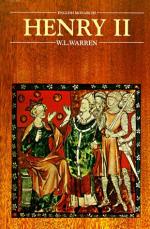the kingdom” should be written down, so that
no question might ever arise as to the laws which
Thomas had sworn to observe; and “wise men”
passed into the next room to write according to the
king’s will. They returned with a draft
of sixteen articles, the famous “Constitutions
of Clarendon.” To these the king commanded
that the Primate should set his seal; but Thomas, agitated
by fear and anxiety, was no longer of the same mind.
“By the omnipotent God,” he cried, “while
I live, I will never set my seal to it!” Whether
he finally submitted it is impossible now to say.
But he left the court with a last protest. A
copy of the writing was torn down the middle, and one
half, after the fashion of the “tallies”
of the day, was given to Thomas in token of his promise,
while the other was laid up in the royal treasury.
“I take this,” said the archbishop, “not
consenting nor approving,” and turning to the
clergy: “By this we may know the malice
of the king, and those things which we must beware
of.” He left the council and retired to
Winchester, where in sackcloth and penance, shut out
from the services of the Church, he condemned himself
to wait in deepest humiliation till he should receive
the Pope’s absolution for his momentary betrayal
of duty. For years to come a furious battle was
to rage round the sixteen articles drawn up at Clarendon.
According to Thomas, the Constitutions were a mere
act of arbitrary violence, a cunning device of tyranny.
He asserted that they were the sole deed of the justiciar
De Lucy, and of Jocelyn de Bailleul, a French lawyer.
In any case he frankly denied the authority of “custom,”
that tyrannous law of medieval times. “God
never said,” writes one of his defenders, “I
am Custom, but I am Truth.” Thomas rested
his case not on the customary law of the land, but
on the code of Rome; to English tradition he opposed
the Italian lawyers. Henry, on his part, declared
that the Constitutions were drawn up by the common
witness of bishops, earls, barons, and wise men; that
they were, in fact, part of a system actually in operation,
and which had been administered by Thomas himself
when he was chancellor. It was certainly a startling
novelty to have the customs of the realm drawn up in
a written code to which men were required to swear
obedience; but still the “Constitutions”
professed to be no new legislation, but to be simply
a statement of recognized national tradition.
The changes that had followed on the Conquest had
modified older customs profoundly. The conditions,
not only of England but of Europe, had changed with
confusing rapidity, and it was no longer easy to say
exactly what was “custom” and what was
not. To Henry the Constitutions did fairly represent
the system which had grown up with general consent
under the Norman kings. Thomas, on the other hand,
might argue with equal conviction that he was asked
to sign as “customs” what was practically
a new code; and he had neither the wisdom nor the
temper to reconcile the dispute by a reasonable compromise.




